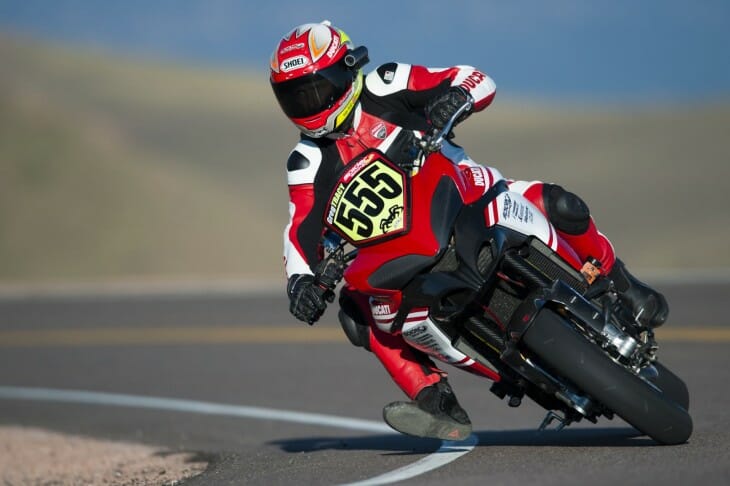Rennie Scaysbrook | December 23, 2015
Much discussion has been going on of late regarding the Pikes Peak International Hill Climb committee’s ruling that for 2016, only motorcycles with one-piece handlebars, i.e nakedbikes like the KTM 1290 Super Duke R, will be allowed to compete.
Below are comments that were made to roadracingworld.com by the Pikes Peak International Hill Climb committee clarifying its stance.
 From now on, you’ll only be allowed to race if your bike comes with a one-piece handlebar from the factory, like the Ducati Multistrada.
From now on, you’ll only be allowed to race if your bike comes with a one-piece handlebar from the factory, like the Ducati Multistrada.
“Although we understand that PPIHC [racing] is inherently dangerous and deaths and injury may occur regardless of what type of bike someone is riding, the decision to make it mandatory to have one-piece handlebars was made based upon the type of bike the committee and BOD is comfortable allowing to race Pikes Peak,” said Megan Leatham, PPIHC Executive Director.
“Once the Committee and BOD determined to keep the motorcycle program in place, changes regarding the bike program had to be made. One common factor in both fatalities [Bobby Goodin, 2014; Carl Sorensen, 2015] was the type of bike both competitors were riding and the BOD is no longer comfortable allowing that type of bike on Pikes Peak.”
Jim Vidmar, PPIHC Assistant Director of Competition, went on to say, “We are striving to strike a balance that will allow motorcycles to continue to compete on Pikes Peak but minimize the risk as much as possible. We are fully aware we will never eliminate the risk completely, but we are taking steps to make the race as safe as possible.”
However, the confusion seems to be around the term, “sportbike.” The ruling applies to motorcycles that have clip-on style handlebars, as Vidmar says, “To clarify, nowhere in the PPIHC Rule Book does it state that sportsbikes are not allowed to compete at the PPIHC. Competitors are more than welcome to apply for an invitation to compete in the PPIHC with a sportsbike as long as it was produced by the manufacturer with one-piece handlebars and the original handlebars are used.”
“One key reason the PPIHC Race Committee and Board of Directors are only comfortable allowing motorcycles originally produced by manufacturers with top mounted one-piece handlebars is the vertical riding position and high vantage point these bikes encourage; motorcycles equipped with clip-on style handles encourage a crouched, horizontal riding position and low vantage point in comparison. The Pikes Peak Highway is an extremely unique race course with many crests and the potential for wildlife like deer, big horn sheep, and even bear to also be on the race course while riders ascend to the mountain’s summit. Due to limiting factors associated with a rider’s ability to see and react as early as possible to these and countless other unpredictable conditions found at Pikes Peak, the PPIHC is no longer comfortable with the riding position and vantage point associated with and encouraged by motorcycles equipped with two-piece clip-on style handles.
“Another benefit to top mounted one-piece handlebars when reacting to unpredictable conditions is their length. In most cases, one-piece handlebars provide a considerably wider reach in comparison to clip-ons. Both handlebars and clip-ons are essentially levers and as levers get longer, less force is required to make them pivot at their fulcrum. When a rider needs to react to something quickly, having these typically longer handlebars makes it easier for them to do so.”